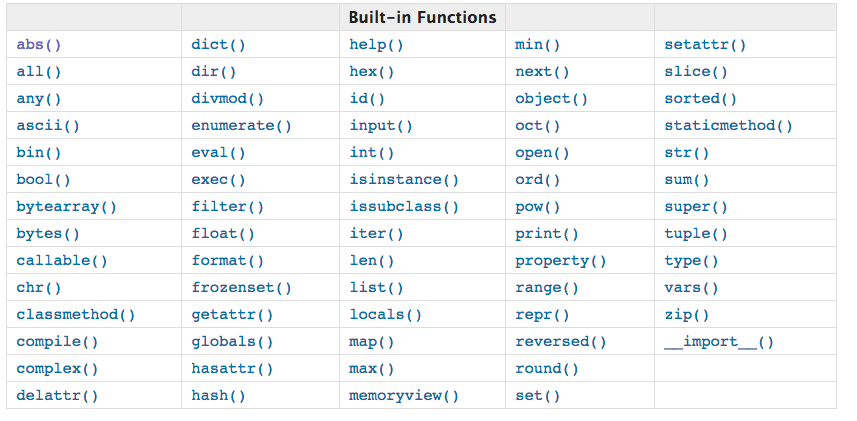
1. abs() 取绝对值函数
1 #!/usr/bin/env python 2 # _*_ coding: UTF-8 _*_ 3 # Author:taoke 4 i = 100 5 print(abs(i)) 6 i = -100 7 print(abs(i))
2.dict() 创建字典
1 print(dict({"a":1, "b":2, "c":3}))
3.help() 帮助函数
4.min() 返回最小项iterable或最小的两个或两个以上的参数。
1 print(min([1,2,34,5,6,7,0,100,-2]))
运行结果:-2
5.setattr() 给对象相应的属性赋值
setattr(x, 'foobar', 123)等同于x.foobar = 123
6.all() 全部为True返回True,否者返回Flase
1 print(all([1,23,45,3,-1])) 2 print(all([1,23,45,3,0,-1]))
运行结果:
True
False
7.ascii() 把一个内存的对象变为可打印的字符串形式
8.bin() 把一个整形转换成二进制字符串
1 print(bin(1)) 2 print(bin(2)) 3 print(bin(3)) 4 print(bin(4)) 5 print(bin(5)) 6 print(bin(255))
运行结果:
0b1
0b10
0b11
0b100
0b101
0b11111111
9.dir()函数不带参数时,返回当前范围内的变量、方法和定义的类型列表;带参数时,返回参数的属性、方法列表。如果参数包含方法__dir__(),该方法将被调用。如果参数不包含__dir__(),该方法将最大限度地收集参数信息。
1 print(dir([1,2,3,4,5]))
运行结果:
['__add__', '__class__', '__contains__', '__delattr__', '__delitem__', '__dir__', '__doc__', '__eq__', '__format__', '__ge__', '__getattribute__', '__getitem__', '__gt__', '__hash__', '__iadd__', '__imul__', '__init__', '__init_subclass__', '__iter__', '__le__', '__len__', '__lt__', '__mul__', '__ne__', '__new__', '__reduce__', '__reduce_ex__', '__repr__', '__reversed__', '__rmul__', '__setattr__', '__setitem__', '__sizeof__', '__str__', '__subclasshook__', 'append', 'clear', 'copy', 'count', 'extend', 'index', 'insert', 'pop', 'remove', 'reverse', 'sort']
10 hex() 转换一个整数对象为十六进制的字符串表示,比如像0x的格式。

1 #!/usr/bin/env python 2 # _*_ coding: UTF-8 _*_ 3 # Author:taoke 4 #将一个整形数转换为十六进制的字符串 5 print(12) 6 print(hex(12)) 7 print(type(hex(12))) 8 print(hex(-127))
11 next() 返回迭代器的下一个项目

1 #!/usr/bin/env python 2 # _*_ coding: UTF-8 _*_ 3 # Author:taoke 4 n = iter([i*i for i in range(10)]) 5 #print(type(n)) 6 for i in range(10): 7 print(next(n))
运行结果:

1 0 2 1 3 4 4 9 5 16 6 25 7 36 8 49 9 64 10 81
12 slice() 切片操作
slice[start, stop, step]: 创建一个slice类型. slice(none)等价于冒号':'. 用法:
s = slice(1,3), a=[1,2,3,4,5,6,7]. 则a[s] == a[1:3] == [2, 3]
多个axis的切片只要把slice类型变量list起来就好~: [s1,s2,...]
可以用于指定axis的切片. 比如要求a在第axis个轴的切片, 从start到end:
slc = [slice(None)]*len(a.shape)
slc[axis] = slice(start,end)
a[slc]即是.
13 any():当传入空可迭代对象时返回False,当可迭代对象中有任意一个不为False,则返回True

1 print(any([0,1,2,3,4])) 2 print(any('1234567890')) 3 #可迭代对象中有一项为True 4 print(any([1,''])) 5 print(any(''+'1')) 6 #可迭代对象中无任意一项为True 7 print(any([0,''])) 8 print(any(''+''))
运行结果:
True
True
True
True
False
False
14 divmod():divmod(a,b)实现a除以b,然后返回商与余数的元组。如果两个参数a,b都是整数,那么会采用整数除法,结果相当于(a//b, a % b)。如果a或b是浮点数,相当于(math.floor(a/b), a%b)。

1 print(divmod(100,20)) 2 print(divmod(100.12,20))
运行结果:
(5, 0)
(5.0, 0.12000000000000455)
15 id() 获取内存地址

1 vir1 = 1232 2 vir2 = 1232 3 vir3 = 22222 4 print(id(vir1)) 5 print(id(vir2)) 6 print(id(vir3))
运行结果:
44024352
44024352
44024368
16 object()
官方文档:
Return a new featureless object. object is a base for all classes. It has the methods that are common to all instances of Python classes. This function does not accept any arguments.
Note:object does not have a __dict__, so you can’t assign arbitrary attributes to an instance of the object class.
翻译:
返回一个新的无特征对象。对象是所有类的基础。它拥有所有Python类实例都通用的方法。此函数不接受任何参数。
注意:对象没有__dict__,所以你不能任意属性分配给对象类的一个实例。
17 sorted()
sorted(iterable, cmp=None, key=None, reverse=False) --> new sorted list
其中第一个参数是可迭代对象,后面的参数都是具有默认值的,重点阐述如下:
1、cmp,比较的函数,这个具有两个参数,参数的值都是从可迭代对象中取出,此函数必须遵守的规则为,大于则返回1,小于则返回-1,等于则返回0
2、key,主要是用来进行比较的元素,只有一个参数,具体的函数的参数就是取自于可迭代对象中,指定可迭代对象中的一个元素来进行排序
3、reverse,是否反转,默认情况下不反转

1 def cmp_value(x,y): 2 if x > y : 3 return 1 4 elif x < y: 5 return -1 6 else: 7 return 0 8 so = sorted('this is a string'.split(' '),cmp=cmp_value) 9 print so
运行结果:
['a', 'is', 'string', 'this']
18 ascii() 返回一个可打印的对象字符串方式表示。当遇到非ASCII码时,就会输出x,u或U等字符来表示。
a = ascii(object) print(a) print(type(a))
运行结果:
<class 'object'>
<class 'str'>
19 enumerate() 函数用于将一个可遍历的数据对象(如列表、元组或字符串)组合为一个索引序列,同时列出数据和数据下标,一般用在 for 循环当中。

1 list1 = [1,2,3,4,5,6] 2 for i,j in enumerate(list1): 3 print(i,j)
20 input() 用来获取控制台的输入。

1 name = input("请输入姓名:") 2 print("名字:%s "%name)
运行结果:
请输入姓名:taoke
名字:taoke
21 oct() 函数将一个整数转换成8进制字符串。

1 t = oct(123) 2 print(type(t)) 3 print(t)
运行结果:
<class 'str'>
0o173
22 staticmethod() 返回一个静态函数对象,主要用来作为静态函数的修饰符。静态函数的特性是可以直接通过类命名空间访问,也就是说没有定义类实例也可以使用此函数;也可以通过类实例来访问。这跟JAVA或C++里的静态函数是一样的作用。

1 class testclass(object): 2 @staticmethod 3 def func1(a,b): 4 print(a , b) 5 6 7 testclass.func1(1,2)
运行结果:
1 2
23 bin() 转换一个整数x为二进制的字符串表示。如果参数x不是一个整数对象,可以通过重载__index__()函数来实现返回一个整数。

1 print(type(bin(123))) 2 print(bin(123))
运行结果:
<class 'str'>
0b1111011
24 eval() 将字符串str当成有效的表达式来求值并返回计算结果

1 str = input("请输入:") 2 obj = eval(str) 3 print(obj)
运行结果:
请输入:1+2+3+4
10
25 int() 函数用于将一个字符串会数字转换为整型

1 print(int(1.23)) 2 print(int(0x123)) 3 print(int('123',10)) 4 print(int('123',16)) 5 print(int('123',8))
运行结果;
1
291
123
291
83
26 open() 函数用于打开一个文件,创建一个 file 对象,相关的方法才可以调用它进行读写。
27 str() 函数将对象转化为适于人阅读的形式。
28 bool() 函数

1 #整数0,浮点数0.0,空列表,空元组,空字典,空字符串,均为False 2 print bool(0.0),bool(0),bool([]),bool(()),bool({}),bool('') 3 #正数,负数均为True 4 print bool(8),bool(-3),bool(-3.9),bool(9.8) 5 #非空列表,非空元组,非空字典,非空字符串均为True 6 print bool([2,3]),bool((3,4)),bool({'name':'song'}),bool('python')
运行结果:
False False False False False False
True True True True
True True True True
10 getattr() 、hasattr()、getattr()和delattr()
setattr():设置对象的某个方法或属性
getattr():运用对象的某个方法或属性
hasattr():判断对象是否存在某种方法或属性
delattr():删除对象某种方法或属性
